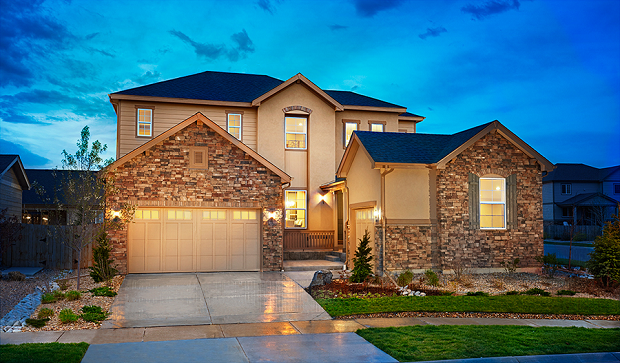Photos sell homes, and no photo is more important than the exterior shot that will be associated with your home’s MLS listing. Ideally, you or your real estate agent should hire a professional real estate photographer to do the job. But, if you’re listing your home independently or have a tight budget, here are some DIY photography tips.
1. If possible, shoot in the spring. Even if you’re planning to stay in your home until fall, don’t let spring pass you by without taking some good exterior photos of your property. New leaves on your trees and shrubs, flowers blooming in their beds and fresh, green grass offer much more curb appeal than snow drifts, sun-stressed turf or bare branches.
Exception: Planned improvements, like a new roof, concrete repairs or landscaping updates are probably worth waiting for.
2. Stage your property for the best photo. Home staging is just as important on your front lawn as it is in your living room—in fact, it can be more important! A little prep time on your home’s exterior may be the difference between a photo that sells and a photo that turns buyers away.
- Put away toys, tools and other clutter. Don’t forget to stash the trash cans!
- Park cars away from the house if they won’t fit in the garage.
- Close the garage door and all other exterior windows and doors.
- Sweep walkways and the driveway. Clean up oil spills on concrete.
- Make sure your lawn and landscaping look their best.
3. Choose the right time of day to take outdoor photography. The direction your home faces, the amount of shade it gets from trees or eaves, and even its paint color can make it hard to guess what time of day will give you the best shot. Thankfully, you don’t have to guess! Try taking a few test photos shortly after dawn, then at mid-morning, mid-afternoon and at twilight to see which is right for your home. Using a digital camera, all it will cost you is time.
Also, if you have the chance, experiment with cloudy and clear days. A slight overcast could cut down on glare, letting the details of your home pop—particularly if you have covered porches or lots of shade trees.
In general, remember:
- Keep the sun at your back. If your home is backlit, everything will be lost in shadow.
- Watch out for glare in windows and other shiny surfaces. If you see them, try changing the angle of your shot.
- If you’re taking early morning or twilight photos, be sure to turn on all interior and exterior lighting. If you’re shooting in bright daylight, keep lights off so windows will be dark in contrast.
4. Frame the best shot. Odds are, a head-on view of your home will not be its most flattering angle. Porches lose their depth, driveways appear too wide and the viewer can’t get a feeling for how spacious the home is inside. Try shooting your house from each of the front corners of the property, and from various points between. You’ll probably find that an angle opposite the driveway gives you a better overall photo because it shows more grass, landscaping and house than garage and pavement.
Tips to consider:
- Find an angle with as few obstructions as possible. Homebuyers aren’t as interested in your shrubbery as they are in the front porch behind it.
- Use a tripod and make sure it’s holding the camera level. You’ll end up with fewer blurry and crooked shots, plus it’s easier to make small adjustments in camera height and angle.
- Try shooting from a ladder or from low on the ground and see if that helps your composition. However, avoid tilting the camera, as that may cause distortions.
- If there’s something unsightly on or near your property, try to avoid letting it into your frame.
- Remember that you can crop your photos later using photo editing software, but you can’t widen a shot after it’s taken. Back up or use a wide-angle lens if you can’t capture the whole house at once.
- Include especially desirable features in your photos, if possible. For example, a paver-stone driveway or sidewalk, a wraparound porch or an obviously new roof may be good selling points to showcase.
Bonus: While you’re taking photos of your home’s exterior, go ahead and get close-ups of your outdoor living spaces. A covered patio, deck, gazebo, outdoor kitchen, pool or other special feature could help your property stand out against the competition.

Example A: Above are two shots of the Hemingway plan in Utah. In the first photo, the driveway dominates the foreground, a small tree blocks the end of the porch and some of the home’s more attractive features are lost in shadow. Simply by changing the angle in the second photo, the photographer was able to avoid the sapling, give the lawn and landscaping a greater share of the spotlight, and add depth to the porch and other architectural details.

Example B: Sometimes, you’ll end up with two different but desirable angles. In the first photo of the Gabrielle plan in Colorado (above), you can see that the home has a bay window, a corner homesite and plenty of space between it and its nearest neighbor. In the second photo, it’s clear that the covered porch actually wraps around the home, providing more space to enjoy the outdoors. However, the angle makes it look like the neighboring house is nearer than it actually is. It’s up to you to weigh the advantages and disadvantages of each shot. You may choose to include both angles in your listing, but only one can be your primary photo.
Looking for photo inspiration? Check out the Find Your New Home section of our website. We have hundreds of professionally photographed exteriors and interiors you can use to get ideas.




